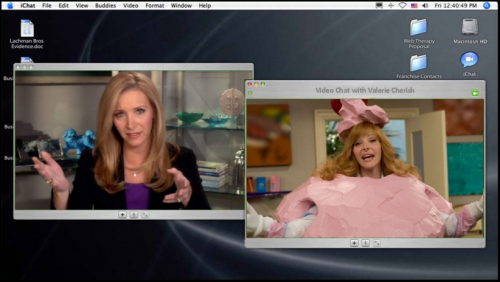
Internet therapist Fiona Wallice should consider reaching out to professional has-been TV “star” Valerie Cherish (quotes mine — Valerie would never question it). It seems Ms. Cherish, last seen on the small screen in the insipid teens-are-dumb-but-fun sitcom Room and Bored, is still trying to regain what little success and stardom she had acquired from her previous TV show I’m It! That show was hailed as one of the most hilarious programs of all time by its laugh track.
But in her quest to be a big star again (???), naturally Valerie can’t see the forest for the galaxy. It appears she is actually going to star as a thinly-veiled version of herself in the upcoming HBO production Seeing Red, written by none other than R&B co-creator/writer Paulie G. This project purports to be, er, G’s unflattering (and inaccurate) dramatization of the supposed egotistical and maniacal transgressions of a TV show’s star actress.
I’m sure Fiona would be only too happy to have the opportunity to have Valerie on Web Therapy, Wallice’s ground-(or is it back?)-breaking Internet “modality” where she attempts to perform psychological counselling for her clients in very short bursts. While Fiona would surely tout the advantages to Valerie of the convenience of videoconferencing over trekking to the therapist’s office, and how the short duration of three minutes per session cuts to the heart of the matter, one suspects that this is only covering up Fiona’s true intent.
By not having people physically present in Fiona’s office, ending the session is as simple as disconnecting the call (isn’t it a bit strange that connection issues seem to occur at the end of a session?), while the revolving door of clients can generate more revenue through sheer volume. And of course there is the added bonus of not having to listen to any more of her clients’ tiresome rambling than she can bear. After all, why should she? She has a unique “modality” that needs backing.
But as Fiona has shown time and again, she knows that a high-profile client can mean a potential windfall. Securing Valerie (and, more to the point, HBO), Ms. Wallice can make “therapeutic” suggestions that might help the self-centered actress but in reality could have Fiona rolling in the dough. If Valerie catches onto this ploy, then Fiona is sly enough to make “clarifications” that would very well fool Valerie.
In some aspects, the two women can be less alike. Fiona is canny enough to know how to manipulate the situations people are in — or at least try to. She subtly make suggestions that lead her victims to believe that she’s absolutely right, and unknowingly plays into her hands. But when Valerie attempts to have things go her way, she overdoes it and it inevitably backfires. Where Fiona tries to put the shoe on the other foot, Valerie has that foot permanently cemented in her mouth.
When Fiona goes too far, she is smart enough to attempt to correct the situation. Take the recent case where she finds her new client Steve Olson has recently won $100 million in a lottery, and who is overwhelmed by the investment proposals he’s been inundated with. Fiona, “graciously” allowing him more than his allotted three minutes, offers to visit with him while she’s in New York City and review what he has received, and advise him on which ones have merit. But in the session with Steve following that meeting, he tells her that he’s on to her game — seems Fiona discarded all the proposals except one: Web Therapy. But Fiona manages to convince him that this was a test, and he passed with flying colors. There’s more to their story, and it’s not a done deal that Fiona has the upper hand.
When Valerie attempts to have things go her way there is the added problem of having a camera filming her every move. When she attends a concert performance by co-castmate and rising music star Juna Millken, Valerie’s husband Mark is all handsy with her as the two dance, but being self-conscious she tells Mark to “give us a few minutes” — “us” being the camera and her. Mark quickly leaves just before Juna calls out Valerie as “looking hot.” Valerie seizes on the moment, dancing wildly, only to then see Mark is dancing with someone else — and both are being handsy with each other.
Fiona may find that she hit the jackpot by helping others in Valerie’s orbit. The actress’ assistant and hairstylist Mickey (Robert Michael Morris) denies he’s gay when he knows he’s being filmed, but when Mickey tries to pitch his boyfriend as a guest star on R&B, Valerie reminds him that an overhead camera is probably on. Mickey’s reaction indicates that the cat is out of the bag (as if there was any question).
While it would appear the two women were meant to meet at some point, there’s only one problem: Fiona is on Showtime, a rival to Valerie’s network, HBO.
Since that last statement has considerably muddied the waters for what are fictional characters let’s switch to the actual reality: that Lisa Kudrow is in the interesting position of concurrently producing and starring in two comedies each on competing pay networks — and where the only thing the two main characters have in common is a desperate need to be successful, albeit for different reasons.
Kudrow herself became a star through Friends, the successful TV show that ran for ten seasons and resulted in her winning many awards for her role as Phoebe Buffay. After the hit ended, she joined forces with Michael Patrick King, who as writer and producer had just completed the final season of Sex in the City. The idea from these two industry powerhouses collaborating on a project was one that HBO probably found too good to refuse, particularly as they were facing the end of two highly successful flagship programs, King’s Sex in the City which would be followed by The Sopranos a couple of years later. The Comeback was a spoof of what at the time was a new concept called reality TV, centering on the efforts of has-been sitcom actress Valerie Cherish to star in a new show Room and Bored while documenting it for the reality program, also called The Comeback.
Unfortunately, Valerie’s disastrous attempts at trying to manipulate situations to go in her favor combined with Paulie G’s vehement contempt for her resulted in the proverbial multiple car pileup where you want to look away but can’t. (Lance Barber is brilliant at depicting Paulie’s unveiled disgust of Valerie, particularly when she foolishly attempts to ingratiate herself with him.)
Val’s reality show producer Jane Bensen (Laura Silverman) also demonstrates that she will do what it takes to get what she feels will result in compelling television — much like actual reality shows do today. She’s not above staging or fabricating situations (e.g., dissatisfied with Valerie’s big announcement that the network picked up R&B, Jane “directs” her to do it over more than once to get the effect Jane wants) or ensuring that the crew films the most private or embarrassing conversations: When Valerie closes a door to prevent the crew from filming a private conversation, Jane instructs them to go outside and clandestinely film Valerie through an open window.
Just as the movie Network predicted news as both entertainment and promoting an agenda (Fox News being the best example), The Comeback was prescient for its time, appearing at the dawning of the reality TV age but giving a glimpse of how that genre would evolve — or devolve, depending on your opinion of those shows. What made the show both perceptive and acerbic was that each episode was not presented as a finished reality TV edited product (except during the last episode, which exposed how Jane manipulated the editing for effect). Instead, the premise was that each episode consisted of the raw footage, where time and again we get to see much more than Valerie wanted filmed: She keeps gesturing “time out” when she wants the cameras to stop filming, but Jane is always adamant that being reality TV, the cameras can’t, and won’t, cease. We get many “candid” glimpses of the principles (including in unexpected environments, like the bedroom), and the reactions from those who are on the sidelines.
The Comeback might have been a bit too far ahead of its time for some periodicals, where the reviews were mixed. Entertainment Weekly’s then-staff member (and later author of Gone Girl) Gillian Flynn gave the show a C rating. In addition, the show had the disadvantage of being one of many buzzy “Hollywood behind the scenes-ish” HBO shows, including Entourage and the impending premiere of Ricky Gervais’ Extras. But the final arbiter was that the ratings weren’t as stellar as HBO expected from this pedigree, and the show was cancelled. HBO’s official reason was that it couldn’t give the show the support it needed considering its already full plate of original programming — including a show with a budget that dwarfed The Comeback: the opulent Rome, which would also come to an unexpected end.
The cancellation resulted in King and Kudrow ending their collaboration, and both moved onto other projects. King would return to Sex in the City, producing and directing the movie version and its sequel, and is currently the executive producer for Two Broke Girls. Kudrow appeared in numerous films and TV shows which included voice work (e.g., The Simpsons), and set up her own production company, producing Who Do You Think You Are? where in each episode a celebrity traces the family tree of one of his or her parents.
Another project that Kudrow was offered was the chance to develop a web series for Lexus, which was launching its own broadband channel. At first she balked at the notion, but Lexus offered her full creative control — and she had already been forming an idea from an earlier request for an online program: what if the webisode involved the actual using of the Internet?
The result was the largely improvised Web Therapy, where Kudrow portrayed former financial manager Fiona Wallice, who becomes a therapist when she’s clearly in the wrong profession, as Fiona wasn’t exactly a people person. Fiona hits on the idea of online, shorter sessions, and sets out to get backers to turn the business into a huge success.
Showtime became involved, moving the webisode to the pay network and exposing it to a larger audience. The entire show consists of Fiona iChatting (formerly Skyping) with clients, family, and friends. Just as in The Comeback where we never see anything that isn’t captured by the reality cameras in Web Therapy we are never taken outside the monitor or close-up of a video-chat window. In both cases, Kudrow uses the medium to convey the action.
The people surrounding Fiona are as dysfunctional as she is. This has provided the show with a dream list of stellar actors, including Lily Tomlin portraying the eccentric and unsupportive mother, Billy Crystal as Fiona’s “stepdad,” and Victor Garber as the recently uncloseted gay husband. Entering its fourth season the roster of stars appearing on Web Therapy is staggering, and it’s apparent that the attraction is the fun everyone is obviously having in playing an assortment of people who are clueless, devious, or both.
Amongst the guests are Lisa Kudrow’s former co-actors from Friends: Davis Schwimmer, Matt LeBlanc, Courteney Cox, and Matthew Perry have all appeared as characters on Web Therapy. And there is at least one crossover between Kudrow’s HBO and Showtime shows: Dan Bucatinsky, who appears in both as well as being executive producer. He also writes for Web Therapy.
Meanwhile The Comeback may have been cancelled, but it was far from being dead and forgotten. It gained a dedicated following through DVD and HBO in demand, and it was reevaluated by the media. Entertainment Weekly called the first season one of the 10 best of the decade, an astounding reversal from the “meh” review at the time of its initial run. HBO noticed, and a second season was offered to Kudrow and King, who were stunned that after being cancelled almost a decade earlier HBO was going to right the wrong of killing the show. Facing the difficult task of working around their current projects the two accepted HBO’s offer and committed to making it happen, securing the services of many of the principal actors from the first season.
Starting the week of November 9, 2014, viewers will get a double dose of Lisa Kudrow, who demonstrates her versatility by the two very different roles: the cold, acidic Fiona and the bubbly, irritating Valerie. In a perfect world, Fiona would have Valerie as a client on Web Therapy, and Valerie could return the favor by pointing her reality cameras at the real Fiona.
That is in a perfect world. But a perfect storm has Lisa Kudrow starring in both roles, and while her characters are far from being perfect, in these shows Kudrow is.
‘The Comeback’ airs at 10 p.m. Sundays on HBO; ‘Web Therapy’ airs at 11 p.m. Wednesdays on Showtime.
©2014 Mike Tiano. All Rights Reserved.
- How the Seattle Cinerama Was Reborn as SIFF Cinema Downtown - April 12, 2024
- Why the Beatles Were the First Global Cultural Phenomenon - February 16, 2024
- A Genesis Prog Lineup: Improbable But Not Impossible - January 29, 2024




